The Acer Swift 3 SF314 Notebook Review: Swift Gets Swifter With Ryzen 4000
by Brett Howse & Andrei Frumusanu on May 5, 2020 8:00 AM ESTDisplay Analysis
Acer offers just a single display option on the 14-inch AMD based Swift 3, which is a 1920x1080 IPS display. Considering the price, this is the right option, although it is interesting that they are offering a 13.5-inch 3:2 Intel based Swift 3 in the SF313-52. The 3:2 works quite well for productivity, although less-so for gaming where 16:9 generally suffers from fewer issues.
There is no touch capability with this display, which is a bit of a shame, but also understandable with the other features offered. Acer did well to hit their target price range, and they made overall good decisions on where to invest. Touch is a nice to have, but not a necessity, although when you are used to having it, it is amazing how often you try to touch the screen.
To see how the display stacks up, the laptop was tested with Portrait Display’s CalMAN software suite. For brightness and contrast, the X-Rite i1Display Pro colorimeter was used, and for color accuracy readings the X-Rite i1Pro 2 spectrophotometer was employed.
Brightness and Contrast
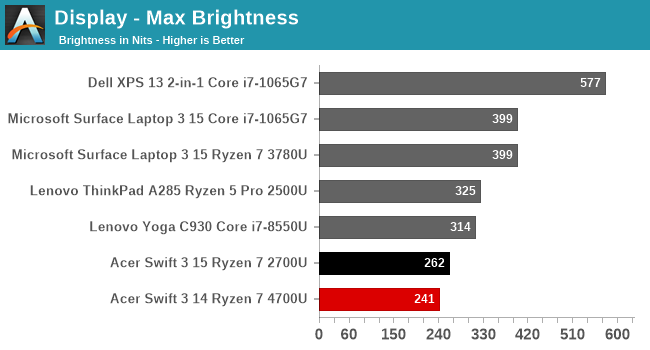
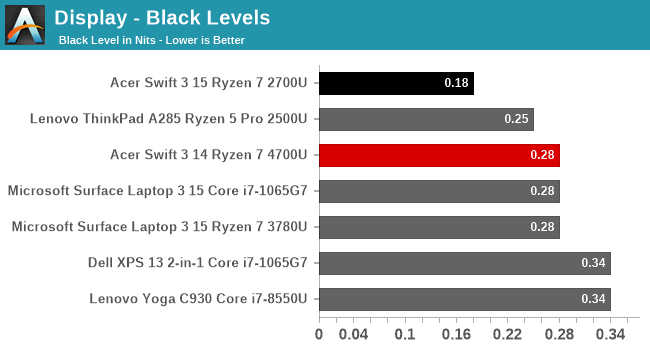
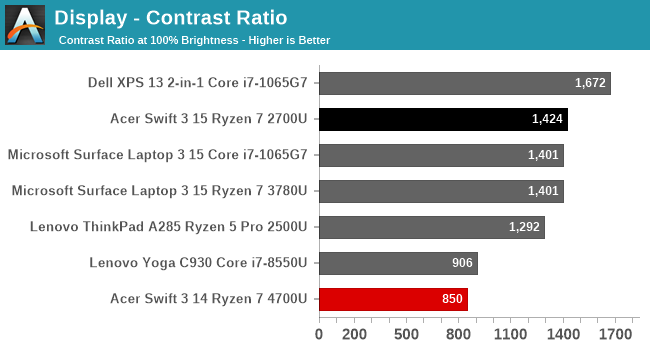
The Acer Swift 3 does not get off to a great start. In a budget notebook, displays tend to be one of the first things on the chopping block. Luckily, we’ve moved past the era where these types of notebooks would offer 1366x768 TN panels, but Acer’s 1920x1080 IPS choice doesn’t offer very good black levels, and their backlight is somewhat weak. It is an inauspicious start.
Grayscale

Grayscale measures the laptops ability to display white levels, from 0% (black) to 100% (white), and the Swift 3 performs quite poorly here. The blue levels are far too strong across most of the range. Gamma is also way off of the expected 2.2 level.
Gamut
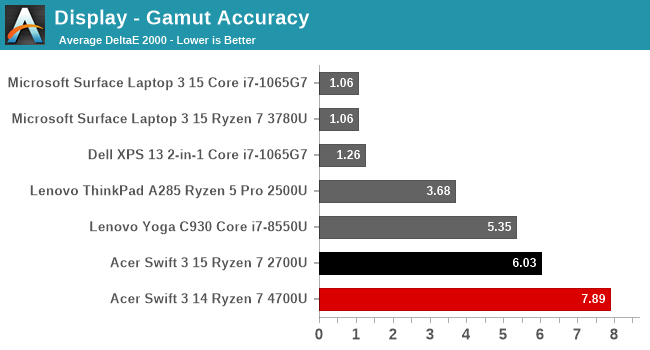
Windows 10 is still an sRGB system first and foremost, so proper sRGB gamut support is required for proper color accuracy. The Acer Swift 3 unfortunately does not cover anywhere near the sRGB gamut, which means that the LED backlighting was likely another area where some money was saved. Although grayscale can be salvaged with some ICC profiles, without full sRGB backlighting this laptop would likely suffer further if an ICC was applied because it simply cannot cover the entire sRGB spectrum.
Saturation
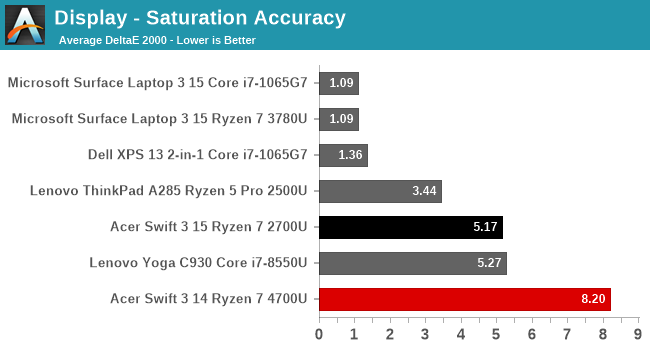
The saturation test covers the primary and secondary colors, but unlike the gamut where they are just measured at 100% level, we test them on 4-bit steps from 0% to 100%. Since we’ve already determined the laptop can’t hit the full sRGB gamut, it is no surprise to see the saturation sweeps suffer.
Gretag Macbeth
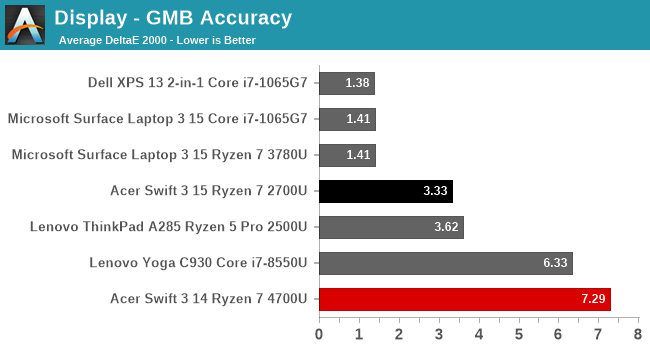
The Gretag Macbeth tests colors off of the primary and secondary axis, including the important skin tones, but with a display that can’t reproduce the entire sRGB range, the Acer Swift 3 naturally performs quite poorly on this test.
Colorchecker
Finally, we have the colorchecker, where you can more easily visualize the color errors with this display. This is a relative test, since any errors in your own display will influence the result, but on the bottom of the swatches is the color requested, and the top shows the color produced by the display. It is not pretty.
Display Conclusion
Overall, despite the poor showing here, the display is in-line with expectations at this price point. Over the last couple of years, there has been a push for better displays, and laptop makers have made the jump to 1920x1080 IPS panels pretty much across the board; so even though this display is poor compared to better IPS-based laptops, it still does offer the good viewing angles an IPS panel enjoys, and 1920x1080 works very well on a 14-inch screen size.
The very poor backlighting really does hamper the capabilities of this notebook. If you wanted to use it for editing photos or video, the internal components like the CPU, memory, and GPU, really would help, but the included display with its lack of sRGB coverage would certainly hinder the work. For basic office tasks, or even gaming, most people who are looking at a laptop at this price point will likely not be too concerned about the display, but just be aware that this one is deficient in several areas.


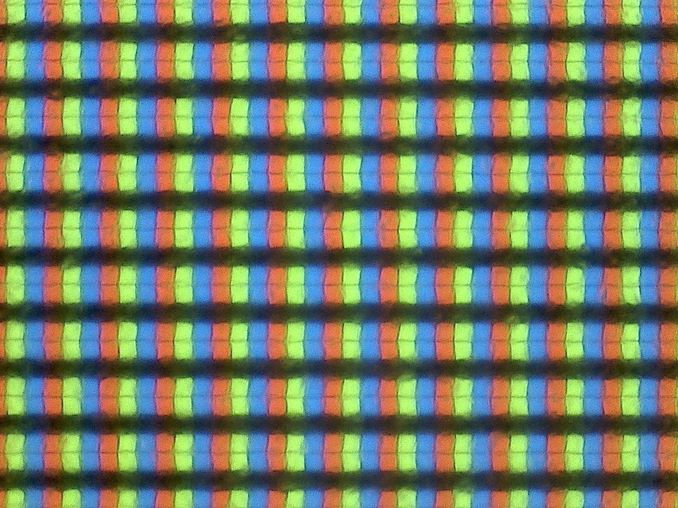













191 Comments
View All Comments
psychobriggsy - Tuesday, May 5, 2020 - link
Yeah, but then you're stuck with two small SODIMMs to replace when you want more memory...My 2700U HP came with 1 8GB stick, buying another stick later on when I needed to double capacity was a lot cheaper than rebuying the full desired capacity.
OTOH 16GB isn't a lot these days - and I'd prefer to get the 16GB in soldered fast LPDDR4X form with Renoir and hope I never need 32GB!
ads295 - Tuesday, May 5, 2020 - link
So I guess you'd have to plan ahead, then. I was going to upgrade to 4x2 initially but I went with 8x2 after some consideration.But would you really need more than 16 if you're a casual user? What are your workloads like? I do light gaming, web browsing and that sort and even 8 would've been enough for me.
fmcjw - Tuesday, May 5, 2020 - link
Lenovo Yoga series was the worst with their single channel atrocities, hope they come to their senses in 2020.Swift 5 2020 (only offered with Intel, no AMD configs I know of) has 8GB onboard with an empty slot running in single channel, but I'm curious how many users think to add another stick. In that case 16GB of onboard RAM is better, at least it reduces BSOD from mismatched RAM.
BTW, if you add a 16GB SO-DIMM to the 8GB onboard, do you get at least the same performance and benefits as 16GB in dual channel mode, or does it create instabilities and other system-wide complications?
csp4me - Tuesday, May 5, 2020 - link
please check your sources man, Swift 5 2020 under 1 kg can never have empty slots, everything is soldered. https://www.notebookcheck.net/Acer-Swift-5-Laptop-...fmcjw - Wednesday, May 6, 2020 - link
You're right, thanks, I got it mixed up with the LG Gram (2020). Acer is soldered.Spunjji - Wednesday, May 6, 2020 - link
Adding a 16GB SO-DIMM to a system with 8GB soldered gives you dual-channel performance for the first 16GB pool of system RAM, with the remaining 8GB running at single-channel performance.neblogai - Tuesday, May 5, 2020 - link
Regarding RAM: at least in China, Swift 3 models with 8GB come with LPDDR4 3200, but there is also a 16GB version, and that uses LPDDR4X 4266, costing ~15% more. It came a ~month later than the 8G model.eddieobscurant - Tuesday, May 5, 2020 - link
I don't understand why they don't offer a model with more ram. 8gb, non-upgradable ram is too low.Holliday75 - Tuesday, May 5, 2020 - link
For who? Most business and casual users 8gb is plenty.My company has 10's of thousands of 8gb laptops deployed and we rarely see the need for more and my users love their huge ass spreadsheets and Chrome. Most home users like my family and friends would be fine with it as their workloads are not as robust.
Me personally I would like 16gb for home use as I game. At work I am happy with my 4th gen Intel processor and 8gb of RAM.
RinzImpulse - Wednesday, May 6, 2020 - link
Umm... don't forget that system RAM will be shared with iGPU, so, most likely you'll only get 6-7 GB free for windows which I'm sure it won't be enough even for most